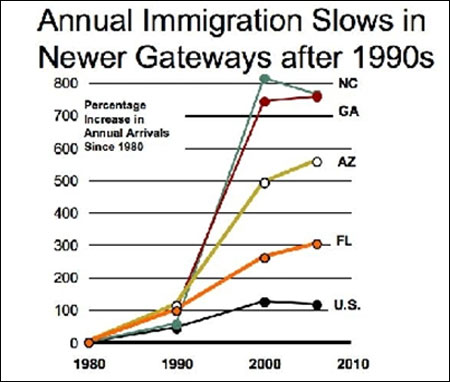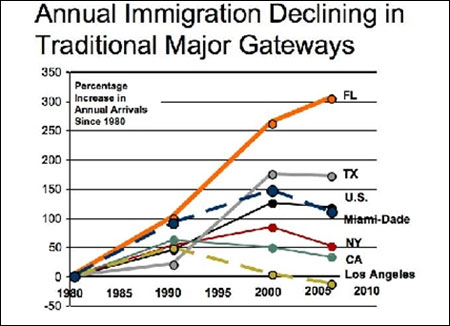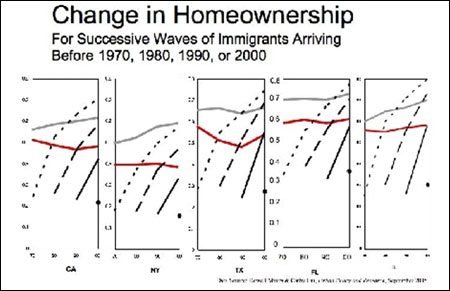A transcript of the recent live webchat with Dowell Myers, PhD about the changing demographics of the U.S. as they relate to urban planning.

On Thursday, March 13, 2008, Planetizen hosted a live online chat session using a new online webchat tool called University WebChat featuring Dowell Myers, Phd. Myers is a professor of urban planning and demography in the School of Policy, Planning, and Development, at the University of Southern California. In this chat, Meyers discusses the country's shifting demographics that will change the face of the nation and talks about what planners should do to handle the change.
Meyers is the author of Immigrants and Boomers: Forging a New Social Contract for the Future of America, which was selected as one of Planetizen's Top Ten Planning Books published in 2007. The following is a transcript of the chat session.
Planetizen: Welcome to this live Planetizen Webchat with demographics expert Dowell Myers, PhD. Thanks for joining us. Feel free to start asking your questions.
Dowell Myers: I feel like a race horse at Santa Anita. We are all in our stalls...there's the starting bell.
Drew: Can you give us some general trends on the changing demographics facing cities?
Dowell Myers: Let me ask first--what is the biggest demographic change in America, would you all say?
Ann: Aging.
Tim Solberg: Aging population.
Dowell Myers: Maybe.
Denise Boswell: I'll second that.
Dowell Myers: What about race?
Drew: Increase in households without children.
Ann: More diversity.
C.J. Gabbe: Immigration and aging?
Peter Conrad: Depends where you are located.
Dowell Myers: Okay, maybe Obama dispensed with that issue... what about immigration? CJ maybe did some book reading...
Peter Conrad: The "new" immigrants seem to be hitting Baltimore now.
Denise Boswell: I oftentimes try to forget that race is still as big of an issue as it is, but I am confronted daily by it here.
Dowell Myers: Are aging and immigration connected?
Denise Boswell: Certainly could be, but are also separate issues.
Vivian: The immigrants are providing services to the aging baby boomers.
C.J. Gabbe: Yes and no. Yes in that immigrants represent many younger entrants to the labor force.
Dowell Myers: One leads to the other.... but aging is the immovable driver
Peter Conrad: We tend to have immigrants stay for only a brief period if they are relocating their families. What sources of data can local government use (other than census) to track these changes? Are there "indicators"?
C.J. Gabbe: Can you describe a little more in depth your recent study showing that sellers outnumber buyers as the population ages and what that means for future housing demand?
Dowell Myers: Let me answer the housing question a little later.... since you are from all over, let's look at some immigration trends that way. Peter asked about data sources. The American Community Survey is annual. We can track immigration that way.
Peter Conrad: We worry about the margin of error in ACS for things like immigration
Dowell Myers: Margin of error is a bigger concern for smaller areas. Data for the whole state is pretty reliable in ACS. If you tried Vermont, however, you would need to worry about error.
Vivian: When we talk about aging, sometimes I worry that we picture a typical baby-boomer... white upper- to middle-class. We also need to be alert about the needs of our aging immigrants and their needs and culture.


Dowell Myers: These two slides show recent trends relative to longer trends. They are expressed as the percent increase in annual immigrant arrivals compared to 1980. In the whole US, immigration peaked in 2000. Did you know that? It peaked in California in 1990. Florida (northern part) and Arizona are still increasing.
USC Dave: What are the long-term implications for California with so much migration to Arizona? What will the California population look like?
Dowell Myers: California has a longer settled immigrant population now. Long settled immigrants have had time to show major upward mobility.
Peter Conrad: Are Florida and Arizona gateways to other areas or are immigrants staying there?
Tracy Sato: And, what is the reason for the significant decrease in the Los Angeles area in particular and is it expected to continue? Do we know these things yet?
Dowell Myers: Tracy, both L.A. and Miami are declining faster than their states. These are the old gateways. They may have filled up and now immigrants are spreading out to new destinations.
Amalia Lorentz: What about trends in age of immigrants (in California)? Are they younger or older now relative to the ‘70s and ‘80s?
Dowell Myers: Amalia, immigrants are always (almost) young when they arrive, as are most migrants. After 20 years they grow 20 years older. So California's immigrants are becoming middle aged. Their children, what we call second generation, are now moving into adulthood.
Peter Conrad: What about Washington DC? I have had developers tell me it and its suburbs are "filled up" and to look for movement to Baltimore.
Dowell Myers: Peter, there is plenty of suburban land in Maryland, but smart growth rules may guide development to the city. Where immigration is new--like North Carolina--they are young and not yet economically advanced.
C.J. Gabbe: So one of the takeaways is that considering immigrations trends is not just important in traditional gateways, but in many other areas of the country as well?

Dowell Myers: The posted slide is missing its legend, so I will explain. The gray line in each state graph is the percent of native born who are owners each decade, 1970 to 2000. The red line is the percent of foreign born who are owners. Not much progress there, huh? But the steep upward trajectories tell the story: the dotted line is immigrants who arrived in the 1960s. The dashed line is arrivals in the ‘70s, the solid line in the 1990s. After 10-20 years they shoot upward into home ownership. Immigrants now account for 40% of the growth of homeowners in America. Next decade it could reach 70-80%. Vivian: Is it true that second to Hispanic immigrants, the second fastest growing sector is the Mormons?
Dowell Myers: The point is that immigration is impacting parts of the nation differently because they are all at different stages. We have virtually no data on religious groups. Most religions track their own numbers in exaggerated ways. Utah, however has exceptionally high fertility. (One of my Chinese students moved there and now he has two babies and he isn't even Mormon.) So let's look at what this means for homeownership. New immigrants are not usually owners. After 20 years however, wow.
Tracy Sato: So, over time, immigrants exceed native born residents in home ownership.
Amalia Lorentz: What about this issue recently picked up by the media that aging boomers selling their bigger houses will further depress the housing market (and by inference, the national economy)? Won't they be moving to smaller units/condos?
Dowell Myers: Older folks sell their homes after a certain age. I have more slides but won't post them just yet. Who is going to buy their house?
Vivian: A young family.
Ann: Hopefully.
Dowell Myers: The key number is that the ratio of seniors to working age will soar by 67% in the next 20 years. This throws everything out of whack. Too many sellers! Immigrants can help. Their children can help even more. Most older voters have not thought about this connection. Local planners are really going to be squeezed. There aren't enough immigrants either. We have 78 million Boomers and 38 million immigrants...
John Lamb: 38 million immigrants ... plus large post baby boom cohorts aging into the market.
Ann: So without immigrants, a community is doomed to vacant homes?
Peter Conrad: So only an asteroid will solve it...
Dowell Myers: Asteroids are not a planning solution!
Dowell Myers: Remedies: keep all your elderly from selling. Make communities elderly attractive.
Vivian: I'm worried about the high number of huge homes being built.... they are too expensive, not green, etc... They will be very difficult to resell.
Dowell Myers: Builders will still produce new homes, but outdated white elephants, as Vivian says, will be a problem.
Peter Conrad: Cities have housing units (above shops for example) that can be converted to other uses.
Amalia Lorentz: What about Gen X and Y? Can they (me!) make up the seller gap?
Dowell Myers: The baby boomers own kids are not proportionately large enough. See, 80% of Boomers are owners, but only 40% of their kids.
Amalia Lorentz: My theory is the boomers kids aren't homeowners yet b/c housing is unaffordable - when prices drop, my generation will buy!
Dowell Myers: This is why I raise the senior ratio as the key metric--it accounts for everyone: number 65 / number 25-64. The ratio was 21 per 100 but will now go to 41 per 100. Housing prices are a paradox...back in a minute on that.
Ann: I've heard talk about a new baby boom...can you comment?
Tracy Sato: The echo boom is just getting out of high school and college - will they be large enough along with the immigrants to buy into the housing? Or, is the focus needed in apartments.
John Lamb: aging of boomers own kids may up the participation ... glutted market may also make housing more affordable (supply and demand) and up participation.
Dowell Myers: The new generation (my sons) are still too young. And they cannot afford today's prices, so they will wait for it to drop. And with too many sellers, it will drop.
C.J. Gabbe: How do household sizes play into future housing demand -- since it's likely that senior households will be smaller and immigrant households may be larger than today's averages?
Dowell Myers: CJ, household size is a paradox also--small Boomers in large houses, and large immigrants overcrowded in small.
John Lamb: Immigrant household size may also mirror trend of larger society over time - fewer persons per household.
Dowell Myers: Basically, builders will cater to retirees. They move out and hand down their large houses. Good system that is sometimes called filtering. But the least desirable homes may be left empty. That could be the outer suburbs, far from transit and service.
Dowell Myers: The story of planning since WWII has been building the suburbs for the Boomers. As they have climbed the age scale and income ladder, we built bigger and bigger. With their retirement, this all could reverse--as detailed in my JAPA article this month.
Vivian: I can see these larger homes will one day be subdivided into apartments - cost less therefore more desirable?
Dowell Myers: Vivian, large homes should be subdivided, but the neighbors won't like that. Zoning fights will prevail. In California we have illegal subdivisions--garages converted, etc.
Peter Conrad: What about the drive distance/gas price issue?
Dowell Myers: That used to be a non-issue. People drove until they qualified for a mortgage. So way out. But this is so rapidly turning. Gas is now hitting $4.00 in CA. it could come back down again, but oeak oil is being hit and we are facing diminished supply.
Peter Conrad: Is there a price point that will drive choices back to the core?
Dowell Myers: Peter, an exact price point? It is all relative and gradual. One day you wake up and it changes. It isn't that people will actually move back to the core, but new buyers will no longer come out to fetch their houses.
Diane Paoni: Since we're talking about driving - can you talk a bit about the disability rate increasing with age.
Dowell Myers: Diane, I do not know enough about disabilities and age. Safe to say, that does increase, and it has implications both for design and location.
Dowell Myers: So what about race? Is it a factor anymore? I think the aging crisis will dominate the next 20 years, and we will look at ethnic minorities as saviors. Really, I think it changes the outlook completely for people who might have not been welcoming before.
Peter Conrad: We see more mixed race neighborhoods in Baltimore (slow trend) but not too many mixed race institutions vital to maintaining places. Newcomers are slow to "join", whatever their race.
Dowell Myers: Peter, right, we need to cultivate more dialogue among groups. Part of that is building institutions.
Tracy Sato: Back on the immigrant issue, are areas that have significant increases in immigrant populations - the new gateways - going to have less of a problem with the single-family development neighborhood than, say declining gateways like LA and Miami?
Dowell Myers: Tracy Sato: I am thinking about this! The new gateways have more buyers in general. It is the old gateways that are going to take the real hit.
John Lamb: This may even out in urban areas and hit rural areas twice as hard.
C.J. Gabbe: Do you see areas that are neither new gateways nor old gateways trying to attract immigrants (and become gateways for immigration)?
Tracy Sato: I am already seeing that areas of LA, like Riverside, have highly diverse neighborhoods with significant numbers of migrants. But older suburbs, like in Orange County which has older suburbs, these may be impacted?
John Lamb: Need to also consider the different migration patterns for larger urban areas versus rural areas - urban areas will probably continue to pull the higher buy rate cohorts even as the larger sell rate cohorts increase.
Dowell Myers: John, areas with job growth will attract the most young people and the potential buyers. It is the Detroits that are facing trouble. Holding their middle-aged residents but not building the young population spells trouble when it comes time to sell. Pittsburgh is trying to attract immigrants as a means of revitalizing the economy. Not enough immigrants to go around...
Peter Conrad: Baltimore has a program as well.
Tracy Sato: How do desirability issues factor in, such as being near the ocean or having great outdoor space? Have these factored into the housing and aging equation?
Dowell Myers: Tracy, the Orange County problem is such high prices...How can young people break in?
Tracy Sato: Very true on the OC side (hence I live in Riverside County).
Peter Conrad: The same things matter to all (whether immigrants or natives: schools, crime, taxes and housing cost.
Glen Bolen: I read an article in Atlantic Monthly recently that stated the country will have an oversupply of around 22 million single-family homes by 2030 - based on changing demographics. How will this surplus affect the efforts to build multifamily housing in urban areas?
Dowell Myers: Glen, the Atlantic article was very short. It drew on a JAPA article by Chris Nelson which produced the stat you cite. Nelson is basically right, although there is some guess work on the specifics. We have been helping each other to get closer to the truth.
Dowell Myers: Multifamily is demanded by people in their 20s. Middle class people pay for new construction. After they have kids they want single-family. During the 1990s we had a shortage of 20s and of multifamily homes. Now we have a resurgence in the 20s, and that augurs well for multifamily homes. The older Boomers also support more dense housing.
Vivian: we're going to have to get creative with re-use of the single-family homes - change zoning, permitted uses.
Dowell Myers: Vivian, you are right. Creative reuse is the name. Local planners are going to have to get ahead of this issue.
USC Dave: In southern Arizona there seems to be many anti-immigration sentiments/laws...will this destroy revitalization/reuse efforts in urban areas?
Dowell Myers: USC Dave, anti-immigrant sentiment has not yet heard what is unfolding. They are longing for the past and are not facing the future. Educate the citizens!
Glen Bolen: It sounds like these current outer ring suburbs could eventually act as a sort of end of the line for urbanization if they become less desirable.
C.J. Gabbe: So part of it comes down to the political feasibility of developing some multifamily (either apartments or condos) in existing single family neighborhoods?
Dowell Myers: CJ, yeah, and for that we have to educate our citizenry about what is happening, what is realistic to do.
Vivian: Reuse the existing single-family homes, particularly those on the edges.
Dowell Myers: It will be a shock in the outer suburbs. They thought they were the most desirable....
Dowell Myers: This hour went by FAST.
Planetizen: Thank you for participating in this live webchat with Dowell Myers, PhD. Be sure to check out Dowell's new book "Immigrants and Boomers: Forging a New Social Contract for the Future of America" -- a Planetizen Top Ten book.
Urban Design for Planners 1: Software Tools
This six-course series explores essential urban design concepts using open source software and equips planners with the tools they need to participate fully in the urban design process.
Planning for Universal Design
Learn the tools for implementing Universal Design in planning regulations.
planning NEXT
Appalachian Highlands Housing Partners
Mpact (founded as Rail~Volution)
City of Camden Redevelopment Agency
City of Astoria
City of Portland
City of Laramie

























